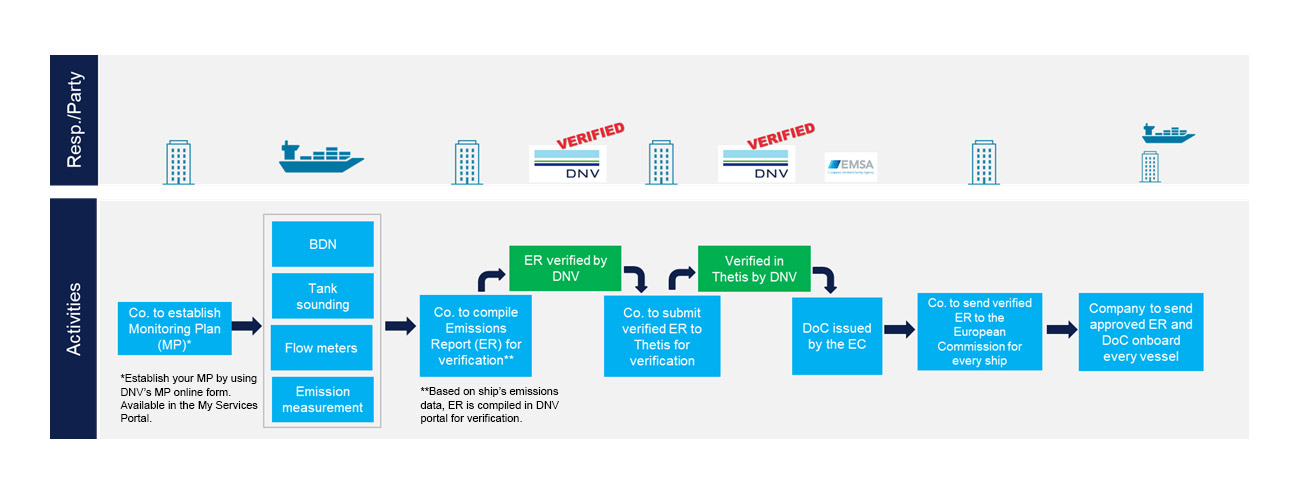In a recent article, DNV highlights that from 1 January 2025, the amended EU MRV regulations will extend to general cargo vessels with a gross tonnage (GT) of 400 to 5000 and offshore vessels of 400 GT and above.
The European Commission (EC) is currently discussing future guidance documents to support stakeholders in meeting MRV obligations in relation to offshore ship emissions.
The EU MRV – a summary
The EU MRV regulation establishes rules, whereby shipping companies report annually, and accredited independent verifiers verify, the reported amounts of carbon dioxide (CO2) emissions and other relevant information from ships calling at EEA ports.
CO2 emissions are the largest component of greenhouse gas emissions from maritime transport, but methane (CH4) and nitrous oxide (N2O) emissions are also important contributors. Hence, in 2023, as part of the package of measures to reduce emissions from the maritime transport sector, the MRV regulation was amended, and after 1 January 2024, the scope of the MRV regulation has expanded to include CH4 and N2O emissions from shipping.
Furthermore, from 1 January 2025, the amended EU MRV regulations will also apply to general cargo ships between 400 and 5000 GT and offshore ships of 400 GT and above. What is an “offshore ship” will shortly be clarified by the EC.

How the EU MRV and EU ETS work together
The EU MRV and the EU ETS are now integrated, and emissions data from the existing EU MRV is the basis for the EU ETS. Even though the EU ETS is not yet mandatory for ships smaller than 5000 GT, general cargo and offshore ships of 400 to 5000 GT will most likely be included from 2027. The EU MRV MP is the basis for the EU ETS, in the following way:
Starting in 2025, the shipping company must submit verified aggregated emissions data at the company level to the administering authority by 31 March of each year. This data is to be based on the MRV Emissions Reports for the previous year. In practice, this means the ship’s Emissions Report needs to be verified and submitted a month earlier, at the latest, than under the current MRV system.
From 2025, the deadline for a verified EU MRV Emissions Report submission to the EC will be 31 March, instead of 30 April. After successful verification of the fleet, MRV Emission Reports and the Company Emission Verification Report containing all the fleet’s EU ETS scope emissions must be submitted to the administering authority by 31 March each year (however, DNV recommends submitting the MRV Emissions Reports for verification at least a month before the deadline).
Do it right – based on DNV’s lessons learned over the years from the EU MRV
Since the early days of the EU MRV in 2018, DNV has verified some 25,000 Emissions Reports, and these are some of the learnings from our work on the EU MRV (and related IMO DCS):
Plan for digital reporting
- Digital (as opposed to manual, ad-hoc) data collection and processing ensures consistency, quality, and continuous feedback – saving time and effort/costs.
- Digital reporting will also fulfil the requirements from other stakeholders, e.g. charterers and financial community, making your operations also more “future-proof” towards other future regulations.
- Establish solid processes for data collection, monitoring, and reporting.
Data quality with financial implications
- While the EU MRV started as a data collection compliance regulation only, the EU MRV has consequences far beyond data collection, and the financial consequences of incorrect reporting, etc. can be significant. Hence, data quality is essential:
- Check the data quality during the year, and be ready before the year’s end.
- Don’t let quality hick-ups stop you from meeting the deadline.
- Improve every year on reporting data.
Start early
- DNV has stressed the importance of starting the process early, and for “new MRV customers”, use the remaining time in 2024 to establish processes.
- Create your Monitoring Plan with DNV’s MRV MP online form (available in the portal, MyServices).
- Upload your MRV emission data today to check the quality and ensure the correct reporting method before the deadline in January 2025. For new MRV customers, you will get access to the MRV reporting template, which will allow us to pre-verify your data quality free of charge for the remainder of 2024.
- Get DNV’s expertise on regulatory and technical issues during the year.
How to get started
This is how “new EU MRV customers” can get started:
- Generate your Monitoring Plan: The template is available on our MyServices portal.
- Start to report as soon as possible: Use the remaining time in 2024 to get the processes in place.
- Try and fail, learn, and improve.
Recommendations
DNV recommends “new EU MRV customers” to follow the DNV lessons learned when starting their efforts for compliance:
- Digital reporting
- Be conscious of data quality: Data quality errors can have financial consequences.
- Start early: Do not wait until 31 December.


































































